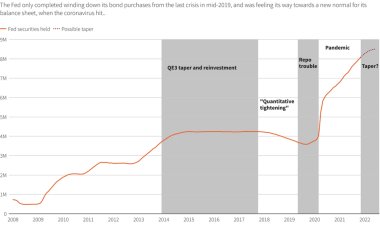11 Cool Investments For This Year

To enjoy a comfortable financial future, investing is absolutely essential for most people. As the coronavirus pandemic demonstrated, a seemingly stable economy can be quickly turned on its head, leaving those who weren’t prepared for tough times scrambling for income.
But with the economy struggling through a bout of high inflation, what are the best investments for investors to make this year? One idea is to have a mix of safer investments and riskier, higher-return ones.
The best investments in 2022:
- High-yield savings accounts
- Short-term certificates of deposit
- Short-term government bond funds
- Series I bonds
- Short-term corporate bond funds
- S&P 500 index funds
- Dividend stock funds
- Value stock funds
- Nasdaq-100 index funds
- Rental housing
- Cryptocurrency
Why invest?
Investing can provide you with another source of income, fund your retirement or even get you out of a financial jam. Above all, investing grows your wealth — helping you meet your financial goals and increasing your purchasing power over time. Or maybe you’ve recently sold your home or come into some money. It’s a wise decision to let that money work for you.
While investing can build wealth, you’ll also want to balance potential gains with the risk involved. And you’ll want to be in a financial position to do so, meaning you’ll need manageable debt levels, have an adequate emergency fund and be able to ride out the ups and downs of the market without needing to access your money.
There are many ways to invest — from very safe choices such as CDs and money market accounts to medium-risk options such as corporate bonds, and even higher-risk picks such as stock index funds. That’s great news, because it means you can find investments that offer a variety of returns and fit your risk profile. It also means that you can combine investments to create a well-rounded and diversified — that is, safer — portfolio.
Overview: Best investments in 2022
1. High-yield savings accounts
A high-yield online savings account pays you interest on your cash balance. And just like a savings account earning pennies at your brick-and-mortar bank, high-yield online savings accounts are accessible vehicles for your cash. With fewer overhead costs, you can typically earn much higher interest rates at online banks. Plus, you can typically access the money by quickly transferring it to your primary bank or maybe even via an ATM.
A savings account is a good vehicle for those who need to access cash in the near future.
Best investment for
A high-yield savings account works well for risk-averse investors, and especially for those who need money in the short term and want to avoid the risk that they won’t get their money back.
Risk
The banks that offer these accounts are FDIC-insured, so you don’t have to worry about losing your deposit. While high-yield savings accounts are considered safe investments, like CDs, you do run the risk of losing purchasing power over time due to inflation, if rates are too low.
Where to open a savings account
You can browse Bankrate’s list of best high-yield savings accounts for a top rate. Otherwise, banks and credit unions offer a savings account, though you may not get the best rate.
2. Short-term certificates of deposit
Certificates of deposit, or CDs, are issued by banks and generally offer a higher interest rate than savings accounts. And short-term CDs may be better options when you expect rates to rise, allowing you to re-invest at higher rates when the CD matures.
These federally insured time deposits have specific maturity dates that can range from several weeks to several years. Because these are “time deposits,” you cannot withdraw the money for a specified period of time without penalty.
With a CD, the financial institution pays you interest at regular intervals. Once it matures, you get your original principal back plus any accrued interest. It pays to shop around online for the best rates.
Because of their safety and higher payouts, CDs can be a good choice for retirees who don’t need immediate income and are able to lock up their money for a little bit.
Best investment for
A CD works well for risk-averse investors, especially those who need money at a specific time and can tie up their cash in exchange for a bit more yield than they’d find on a savings account.
Risk
CDs are considered safe investments. But they do carry reinvestment risk — the risk that when interest rates fall, investors will earn less when they reinvest principal and interest in new CDs with lower rates, as we saw in 2020 and 2021. The opposite risk is that rates will rise and investors won’t be able to take advantage because they’ve already locked their money into a CD. And with rates expected to rise further in 2022, it may make sense to stick to short-term CDs, so that you can reinvest at higher rates in the near future.
It’s important to note that inflation and taxes could significantly erode the purchasing power of your investment.
Where to buy a CD
Bankrate’s list of best CD rates will help you find the best rate across the nation, instead of having to rely on what’s available only in your local area. Alternatively, banks and credit unions typically offer CDs, though you’re not likely to find the best rate locally.
3. Short-term government bond funds
Government bond funds are mutual funds or ETFs that invest in debt securities issued by the U.S. government and its agencies. Like short-term CDs, short-term government bond funds don’t expose you to much risk when interest rates rise, as they’ve done to start 2022.
The funds invest in U.S. government debt and mortgage-backed securities issued by government-sponsored enterprises such as Fannie Mae and Freddie Mac. These government bond funds are well-suited for the low-risk investor.
These funds can also be a good choice for beginning investors and those looking for cash flow.
Best investment for
Government bond funds may work well for risk-averse investors, though some types of funds (like long-term bond funds) may fluctuate a lot more than short-term funds due to changes in the interest rate.
Risk
Funds that invest in government debt instruments are considered to be among the safest investments because the bonds are backed by the full faith and credit of the U.S. government.
If interest rates rise, the prices of existing bonds drop; and if interest rates decline, the prices of existing bonds rise. Interest rate risk is greater for long-term bonds than it is for short-term bonds, however. Short-term bond funds will have minimal impact from rising rates, and the funds will gradually increase their interest rate as prevailing rates rise.
However, if inflation stays high, the interest rate may not keep up and you’ll lose purchasing power.
Where to get it
You can buy bond funds at many online brokers, namely those that allow you to trade ETFs or mutual funds. Most brokers that offer ETFs allow you to buy and sell them at no commission, while mutual funds may require you to pay a commission or make a minimum purchase, though not always.
4. Series I bonds
The U.S. Treasury issues savings bonds for individual investors, and an increasingly popular option in 2022 is the Series I bond. This bond helps build in protection against inflation. It pays a base interest rate and then adds on a component based on the inflation rate. The result: If inflation rises, so does the payout. But the reverse is true: If inflation falls, so will the interest rate. The inflation adjustment resets every six months.
Series I bonds earn interest for 30 years if they are not redeemed for cash.
Best investment for
Like other government-issued debt, Series I bonds are attractive for risk-averse investors who do not want to run any risk of default. These bonds are also a good option for investors who want to protect their investment against inflation. However, investors are limited to buying $10,000 in any single calendar year, though you can apply up to an additional $5,000 in your annual tax refund to the purchase of Series I bonds, too.
Risk
The Series I bond protects your investment against inflation, which is a key downside to investing in most bonds. And like other government-issued debt, these bonds are considered among the safest in the world against the risk of default.
Where to get it
You can buy Series I bonds directly from the U.S. Treasury at treasurydirect.gov. The government will not charge you a commission for doing so.
5. Short-term corporate bond funds
Corporations sometimes raise money by issuing bonds to investors, and these can be packaged into bond funds that own bonds issued by potentially hundreds of corporations. Short-term bonds have an average maturity of one to five years, which makes them less susceptible to interest rate fluctuations than intermediate- or long-term bonds.
Corporate bond funds can be an excellent choice for investors looking for cash flow, such as retirees, or those who want to reduce their overall portfolio risk but still earn a return.
Best investment for
Short-term corporate bond funds can be good for risk-averse investors who want a bit more yield than government bond funds.
Risk
As is the case with other bond funds, short-term corporate bond funds are not FDIC-insured. Investment-grade short-term bond funds often reward investors with higher returns than government and municipal bond funds.
But the greater rewards come with added risk. There is always the chance that companies will have their credit rating downgraded or run into financial trouble and default on the bonds. To reduce that risk, make sure your fund is made up of high-quality corporate bonds.
Where to get it
You can buy and sell corporate bonds funds with any broker that allows you to trade ETFs or mutual funds. Most brokers allow you to trade ETFs for no commission, whereas many brokers may require a commission or a minimum purchase to buy a mutual fund.
6. S&P 500 index funds
If you want to achieve higher returns than more traditional banking products or bonds, a good alternative is an S&P 500 index fund, though it does come with more volatility.
The fund is based on about five hundred of the largest American companies, meaning it comprises many of the most successful companies in the world. For example, Amazon and Berkshire Hathaway are two of the most prominent member companies in the index.
Like nearly any fund, an S&P 500 index fund offers immediate diversification, allowing you to own a piece of all of those companies. The fund includes companies from every industry, making it more resilient than many investments. Over time, the index has returned about 10 percent annually. These funds can be purchased with very low expense ratios (how much the management company charges to run the fund) and they’re some of the best index funds.
An S&P 500 index fund is an excellent choice for beginning investors, because it provides broad, diversified exposure to the stock market.
Best investment for
An S&P 500 index fund is a good choice for any stock investor looking for a diversified investment and who can stay invested for at least three to five years.
Risk
An S&P 500 fund is one of the less-risky ways to invest in stocks, because it’s made up of the market’s top companies and is highly diversified. Of course, it still includes stocks, so it’s going to be more volatile than bonds or any bank products. It’s also not insured by the government, so you can lose money based upon fluctuations in value. However, the index has done quite well over time.
The index rallied furiously after its pandemic-driven plunge in March 2020, but has performed poorly in 2022, so investors may want to proceed with caution and stick to their long-term investment plan.
Where to get it
You can purchase an S&P 500 index fund at any broker that allows you to trade ETFs or mutual funds. ETFs are typically commission-free, so you won’t pay any extra charge, whereas mutual funds may change a commission and require you to make a minimum purchase.
7. Dividend stock funds
Even your stock market investments can become a little safer with stocks that pay dividends.
Dividends are portions of a company’s profit that can be paid out to shareholders, usually on a quarterly basis. With a dividend stock, not only can you gain on your investment through long-term market appreciation, you’ll also earn cash in the short term.
Buying individual stocks, whether they pay dividends or not, is better suited for intermediate and advanced investors. But you can buy a group of them in a stock fund and reduce your risk.
Best investment for
Dividend stock funds are a good selection for almost any kind of stock investor but can be better for those who are looking for income. Those who need income and can stay invested for longer periods of time may find these attractive.
Risk
As with any stock investments, dividend stocks come with risk. They’re considered safer than growth stocks or other non-dividend stocks, but you should choose your portfolio carefully.
Make sure you invest in companies with a solid history of dividend increases rather than selecting those with the highest current yield. That could be a sign of upcoming trouble. However, even well-regarded companies can be hit by a crisis, so a good reputation is finally not a protection against the company slashing its dividend or eliminating it entirely.
However, you eliminate many of these risks by buying a dividend stock fund with a diversified collection of assets, reducing your reliance on any single company.
Where to get it
Dividend stock funds are available as either ETFs or mutual funds at any broker that deals in them. ETFs may be more advantageous, because they often have no minimum purchase amount and are typically commission-free. In contrast, mutual funds may require a minimum purchase and your broker may charge a commission for them, depending on the broker.
8. Value stock funds
With the run-up in many stocks in the last couple years potentially leading to significant overvaluation, many investors are wondering where they can put their investment dollars. Value stock funds may be a good option. These funds invest in value stocks, those that are more bargain-priced than others in the market. Plus, value stocks tend to do better as interest rates rise.
Many value stock funds also pay a dividend, so that’s an additional attraction for many investors.
Best investment for
Value stock funds are good for investors who are comfortable with the volatility associated with investing in stocks. Investors in stock funds need to have a longer-term investing horizon, too, at least three to five years to ride out any bumps in the market.
Risk
Value stock funds will tend to be safer than other kinds of stock funds because of their bargain price, but they’re still composed of stocks, so they will fluctuate a lot more than safer investments such as short-term bonds. Value stock funds are not insured by the government, either.
Where to get it
Value stock funds can come in two major types: ETFs or mutual funds. ETFs are usually available commission-free and without a minimum purchase requirement at most major online brokers. However, mutual funds may require a minimum purchase and online brokers may charge a commission to trade them.
9. Nasdaq-100 index funds
An index fund based on the Nasdaq-100 is a great choice for investors who want to have exposure to some of the biggest and best tech companies without having to pick the winners and losers or having to analyze specific companies.
The fund is based on the Nasdaq’s 100 largest companies, meaning they’re among the most successful and stable. Such companies include Apple and Meta Platforms, each of which comprises a large portion of the total index. Microsoft is another prominent member company.
A Nasdaq-100 index fund offers you immediate diversification, so that your portfolio is not exposed to the failure of any single company. The best Nasdaq index funds charge a very low expense ratio, and they’re a cheap way to own all the companies in the index.
Best investment for
A Nasdaq-100 index fund is a good selection for stock investors looking for growth and willing to deal with significant volatility. Investors should be able to commit to holding it for at least three to five years. Using dollar-cost averaging to buy into an index fund trading at all-time highs can help reduce your risk, compared to buying in with a lump sum.
Risk
Like any publicly traded stock, this collection of stocks can move down, too. While the Nasdaq-100 has some of the strongest tech companies, these companies also are usually some of the most highly valued. That high valuation means that they’re likely prone to falling quickly in a downturn, as they’ve done to start the year, though they may rise again during an economic recovery.
Where to get it
Nasdaq-100 index funds are available as both ETFs and mutual funds. Most brokers allow you to trade ETFs without a commission, while mutual funds may charge a commission and have a minimum purchase amount.
10. Rental housing
Rental housing can be a great investment if you have the willingness to manage your own properties. And despite mortgage rates climbing higher, it still may be a good time to finance the purchase of a new property, though the unstable economy may make it harder to actually run it.
To pursue this route, you’ll have to select the right property, finance it or buy it outright, maintain it and deal with tenants. You can do very well if you make smart purchases. However, you won’t enjoy the ease of buying and selling your assets in the stock market with a click or a tap on your internet-enabled device. Worse, you might have to endure the occasional 3 a.m. call about a broken pipe.
But if you hold your assets over time, gradually pay down debt and grow your rents, you’ll likely have a powerful cash flow when it comes time to retire.
Best investment for
Rental housing is a good investment for long-term investors who want to manage their own properties and generate regular cash flow.
Risk
As with any asset, you can overpay for housing, as investors in the mid-2000s found out. With low interest rates and a tight housing supply, housing prices surged in 2020 and 2021, despite the economy’s struggles. Also, the lack of liquidity might be a problem if you ever needed to access cash quickly. You may have to come up with serious cash for some expenses, such as a new roof or air conditioning, if they’re needed, and inflation may dramatically affect the costs of replacing these items. Of course, you’ll run the risk of the property sitting empty while you’re still paying the mortgage.
Where to get it
You’ll likely need to work with a real estate broker to find rental housing, or you can work on building out a network that may be able to source you better deals before they hit the market.
11. Cryptocurrency
Cryptocurrency is a kind of digital electronic-only currency that is intended to act as a medium of exchange. It has become a hot property in the last few years in particular, as dollars flew into the asset, pushing up prices and drawing even more traders to the action.
Bitcoin is the most widely available cryptocurrency, and its price fluctuates a lot, attracting many traders. For example, from a price below $10,000 a coin at the start of 2020, Bitcoin soared to around $30,000 at the start of 2021. Then it doubled above the $60,000 mark, before falling back significantly in 2022.
This year has been particularly rough for cryptocurrency, with most of the top cryptos declining sharply. However, many cryptos such as Bitcoin are coming off all-time highs, so those who bought years ago and held (or HODL) may still be sitting on some pretty nice gains, despite the recent plunge.
Unlike other assets listed here, it’s not backed by the FDIC or the money-generating power of either a government or company. Its worth is determined solely by what traders will pay for it.
Best investment for
Cryptocurrency is good for risk-seeking investors who wouldn’t mind if their investment goes to zero in exchange for the potential of much higher returns. It’s not a good choice for risk-averse investors or those who need any kind of safe investment.
Risk
Cryptocurrency has very significant risks, including ones that could turn any individual currency into a complete zero, such as being outlawed or heavily regulated. Digital currencies are highly volatile and may fall (or rise) precipitously even over very short time frames, and the price depends entirely on what traders will pay. Traders also run some risk of being hacked, given some high-profile thefts in the past. And if you’re investing in cryptocurrencies, you’ll have to pick the winners that manage to stick around, when many could well disappear entirely.
Where to get it
Cryptocurrency is available at many brokers, including Interactive Brokers, Webull and TradeStation, but often these sources have a selection that is limited to the most popular coins. In contrast, a crypto exchange such as Binance or Coinbase may have hundreds of available cryptos, from the most popular to the relatively obscure.
What to consider
As you’re deciding what to invest in, you’ll want to consider several factors, including your risk tolerance, time horizon, your knowledge of investing, your financial situation and how much you can invest.
If you’re looking to grow wealth, you can opt for lower-risk investments that pay a modest return, or you can take on more risk and aim for a higher return. There’s typically a trade-off in investing between risk and return. Or you can take a balanced approach, having absolutely safe money investments while still giving yourself the opportunity for long-term growth.
The best investments for 2022 allow you to do both, with varying levels of risk and return.
Risk tolerance
Risk tolerance means how much you can withstand when it comes to fluctuations in the value of your investments. Are you willing to take big risks to potentially get big returns? Or do you need a more conservative portfolio? Risk tolerance can be psychological as well as simply what your personal financial situation requires.
Conservative investors or those nearing retirement may be more comfortable allocating a larger percentage of their portfolios to less-risky investments. These are also great for people saving for both short- and intermediate-term goals. If the market becomes volatile, investments in CDs and other FDIC-protected accounts won’t lose value and will be there when you need them.
Those with stronger stomachs, workers still accumulating a retirement nest egg and those with a decade or more until they need the money are likely to fare better with riskier portfolios, as long as they diversify. A longer time horizon allows you to ride out the volatility of stocks and take advantage of their potentially higher return, for example.
Time horizon
Time horizon simply means when you need the money. Do you need the money tomorrow or in 30 years? Are you saving for a house down payment in three years or are you looking to use your money in retirement? Time horizon determines what kinds of investments are more appropriate.
If you have a shorter time horizon, you need the money to be in the account at a specific point in time and not tied up. And that means you need safer investments such as savings accounts, CDs or maybe bonds. These fluctuate less and are generally safer.
If you have a longer time horizon, you can afford to take some risks with higher-return but more volatile investments. Your time horizon allows you to ride out the ups and downs of the market, hopefully on the way to greater long-term returns. With a longer time horizon, you can invest in stocks and stock funds and then be able to hold them for at least three to five years.
It’s important that your investments are calibrated to your time horizon. You don’t want to put next month’s rent money in the stock market and hope it’s there when you need it.
Your knowledge
Your knowledge of investing plays a key role in what you’re investing in. Investments such as savings accounts and CDs require little knowledge, especially since your account is protected by the FDIC. But market-based products such as stocks and bonds require more knowledge.
If you want to invest in assets that require more knowledge, you’ll have to develop your understanding of them. For example, if you want to invest in individual stocks, you need a great deal of knowledge about the company, the industry, the products, the competitive landscape, the company’s finances and much more. Many people don’t have the time to invest in this process.
However, there are ways to take advantage of the market even if you have less knowledge. One of the best is an index fund, which includes a collection of stocks. If any single stock performs poorly, it’s likely not going to affect the index much. In effect, you’re investing in the performance of dozens, if not hundreds, of stocks, which is more a wager on the market’s overall performance.
So you’ll want to understand the limits of your knowledge as you think about investments.
How much you can invest
How much can you bring to an investment? The more money you can invest, the more likely it’s going to be worthwhile to investigate higher-risk, higher-return investments.
If you can bring more money, it can be worthwhile to make the time investment required to understand a specific stock or industry, because the potential rewards are so much greater than with bank products such as CDs.
Otherwise, it may not simply be worth your time. So, you may stick with bank products or turn to ETFs or mutual funds that require less time investment. These products can also work well for those who want to add to the account incrementally, as 401(k) participants do.
Bottom line
Investing can be a great way to build your wealth over time, and investors have a range of investment options, from safe lower-return assets to riskier, higher-return ones. That range means you’ll need to understand the pros and cons of each investment option and how they fit into your overall financial plan in order to make an informed decision. While it seems daunting at first, many investors manage their own assets.
But the first step to investing is actually easy: opening a brokerage account. Investing can be surprisingly affordable even if you don’t have a lot of money. (Here are some of the best brokers to choose from if you’re just getting started.)
Recap of the 11 best investments in 2022
- High-yield savings accounts
- Short-term certificates of deposit
- Short-term government bond funds
- Series I bonds
- Short-term corporate bond funds
- S&P 500 index funds
- Dividend stock funds
- Value stock funds
- Nasdaq-100 index funds
- Rental housing
- Cryptocurrency















